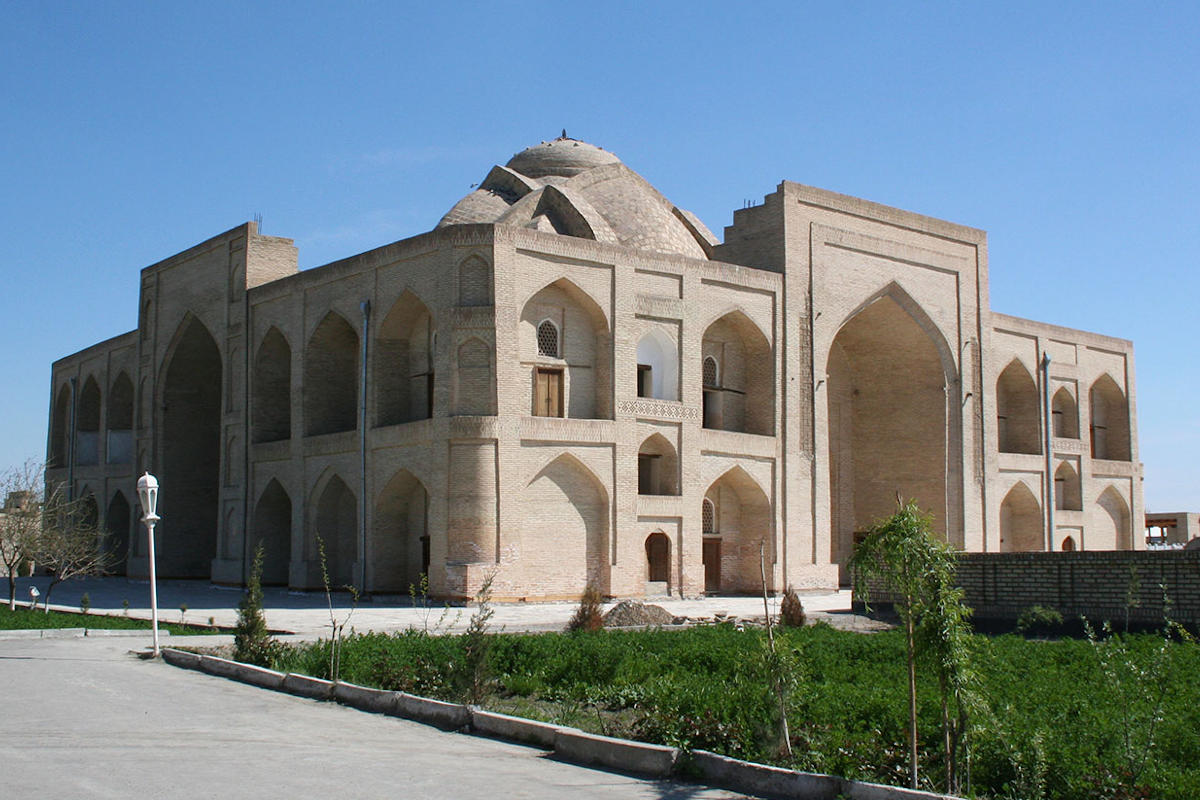Bukhara - Bahauddin Naqshbandi Complex
The Bahauddin Naqshbandi Complex is located on the outskirts of Bukhara, in the village of Kasri-Orifon. The monument complex at the saint’s tomb was rebuilt several times, as each ruler of Bukhara considered it his duty to make his own additions.
The preserved ensemble of Bahauddin’s tomb includes a majestic khanaka – a Sufi dwelling built by Khan Abdulaziz in 1545. The large mosque with two aivans, one of which surmounts the minaret, was built in the mid-18th century for Khan Abulfeyz’s mother.

The Bahauddin Naqshbandi Complex in Bukhara took the typical XVIth century form of combining a necropolis with a ceremonial building. In 1544, the Sheikh of Abdulazizkhan I was buried in the form of a floor vault – dakhma with a marble carved fence on top.
The mother of the ruler Abulfeyz-khan (1711-1747) had a mosque with two aivans (terraces) built from her own funds, and in the XIX century the vizier of Nasrulla-khan Hakim Kushbegi had another mosque built.
The minaret (tower) was built in 1720. During the Soviet period, this sanctuary was in a state of devastation. The other mosque, located in the inner part of the necropolis courtyard, was built almost a century later by Hakim Kushbegi.
Interesting events are connected with the construction of the road from Bukhara to the sacred necropolis. The story of its construction is presented in the biography of the Bukhara emirs as follows: “Emir Nasrulla-khan Bokhadur was in the city of Karshi before the death of his father Kushbegi”.
In 1826, the blessed Emir Haydar died and the throne of Bukhara was inherited by Prince Hussein, who ruled from 6 October to 19 December of the same year and was then poisoned by his brother Omar-khan, Omar-khan also ruled Bukhara only briefly – for four months.
Emir Nasrullah, having gathered an army and enlisted the support of Hakim Kushbegi, undertook a campaign to Bukhara to punish the fratricide. A few days before his accession, Emir Nasrullah left his army near Faiziabad and visited the tomb of the holy Sheikh Bahauddin, where he vowed: “If I become Emir, I will make a weekly hajj on foot from Bukhara to the tomb of the holy Sheikh”. On 24 April 1827, Nasrullah Khan Bokhadur ascended the throne.
As he had promised, he made his first hajj to the Mazar of Bahauddin. The young emir ordered the road to be paved from the gates of noble Bukhara to the sacred mazar of Sheikh Bahauddin.
His order was soon carried out. The last Emir of Bukhara, Sayyid Mir Alimkhan, continued the traditions of his predecessors and built several public buildings near the necropolis, including a large guesthouse and a large bathhouse.
The Bahauddin Naqshbandi complex in Bukhara was built permanently. Here, in the complex, there are also two holy wells. To Sheikh Bahauddin, whose full name is Sayyid Muhammad Bahauddin Naqshbandi ibn Sayyid Jalaliddin, thousands of pilgrims, tourists and Muslim believers travel and wander at all times.
A pilgrimage to this holy place three times is equivalent to a Hajj to Mecca. Sheikh Bahauddin’s name was the most revered in these parts after that of Prophet Muhammad.
Whenever a believer wished for good fortune, he would pray to Sheikh Bahauddin and invoke the magic words “Ya Bahauddini bola gardon” as a spell to ward off trouble. (“O Bahauddin, saviour from trouble”).
According to the believers, it helped them to protect themselves from the unclean. People invoke Bahauddin’s holiness when they want to protect themselves from corruption and disease or ask for blessings on the way.
And so it happened that whoever asked the saint for intercession or help always got it. The mausoleum is considered one of the most popular pilgrimage sites for Muslims, as three pilgrimages to the mausoleum of Bahauddin Naqshbandi are equivalent to one pilgrimage to Mecca.
An interesting attraction of the complex is the Naqshbandi’s staff. According to legend, the Sheikh stuck his staff into the ground and it began to grow and eventually became a tree.
In its niches lie the donations of the pilgrims. It is believed that after asking the sheikh to intercede in any noble deeds, one should go under the staff. After Uzbekistan’s independence, the shrine was restored in honour of Bahauddin Naqshband’s 675th birthday in 1993.
The darvazakhana (entrance hall) was built with a high dome. The magnificently decorated Aivans – terraces were replicated. An extensive garden connected the sacred tomb of Hazrat Bahauddin and the tomb of his mother in a single composition.
Dakhmai Shohon (Necropolis of Rulers) was also restored, where the remains of some rulers from the Temurid, Shaibanid, Ashtarkhanid and Mangyte dynasties are buried.
